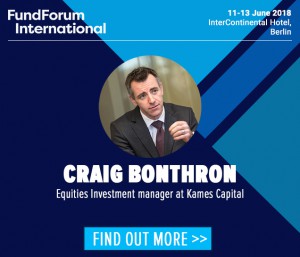Positive (second-order) impact: Investors should go deeper to find hidden gems in impact investing

Craig Bonthron, Equities Investment manager at Kames Capital, is responsible for co-managing global equities portfolios. In this feature he discusses why all may be not what it seems with positive impact investing. Join Craig at FundForum International 2018 where he will discuss: How to integrate ESG in the portfolio? Best practice from fund buyers and leading providers on the most effective and beneficial approaches.
Positive impact investing is a popular term these days and has become synonymous with investing in companies that do something ‘good.’ This is understandable but unfortunate. Why? It opens the door to poor investment solutions that are built on the simplistic fallacy that companies that make something ‘good’ also are good investments.
Themed funds are one example. They benefit from simple concepts, such as solving the world’s water problems or harnessing the power of the wind or the sun. These ideas sound good, look good and feel good, but are they any good? No. Why?
First, these funds rarely do what they say they do. The idea of a water fund, for example, can be very different from the reality of the companies you are actually investing in. For example, it could well be manufacturers of expensive taps for luxury homes (not exactly helping to ‘solve’ a water crisis) or it could be a pump manufacturer that is 90% exposed to the oil and gas industry. Second, with such a limited range of options, thematic funds tend to back the losers as well as the winners. Over time, returns between each stock within any theme will vary widely depending on stock specifics. That’s no good if you hold them all. Third, the lack of options within any particular theme means managers can end-up shoehorning ideas into the funds that can either be bad investments or questionable in terms of thematic exposure (thereby diluting their exposure to the actual theme). Fourth, there’s the law of unintended consequences. Thematic funds deliver unplanned factor risks that drown-out stock-picking and are often contradictory to the intended theme.
We believe that sustainable investing done the right way can offer clients the potential for a positive impact with their capital while also potentially outperforming the market. Indeed, our sustainability fund is built on the founding premise that we will never invest in anything simply because it sounds good, instead we seek out companies that capture economic value from doing good, and invest at an attractive price.
We analyse the positive and negative impacts of all our investments using our three dimensions of sustainability: product, practices and improvement. Gaining meaningful insight necessitates that we think through second and third-order impacts to identify differentiated, sustainable, growth investments for our clients.
But here’s the thing, we don’t need to invest in wind turbine, solar panel, water pump or electric vehicle manufacturers to achieve this. Indeed, poor business models, industry dynamics and valuations often prevent us from doing so.
Yet this does not mean we don’t deliver a positive impact with our clients’ capital. We continually uncover unappreciated gems with positive impact even if this is not obvious at first glance. Sometimes via their practices (i.e. how they operate) but more often via the second-order impacts of their products… and these less obvious impacts are often meaningful indeed. And let’s be clear, this is definitely not achieved via a top-down process of screening for companies that sound good.
We invest in lots of these positive second-order impactors, but here are a select few to ponder:
- Coherent is just a laser maker, however, their product is vital to produce OLED panels and electric vehicle batteries. OLED screens reduce energy consumption of smartphones versus LCD screens – that’s a lot of energy saved (if deployed across seven billion phones).
- MarketAxess is just a bond trading platform, but it has increased price transparency and liquidity that makes trading fairer and more accessible to smaller traders.
- WorldPay is just a merchant acquirer for payment processors, but it enables increased electronic ‘cashless’ payments that meaningfully reduces money laundering and corruption.
- Mohawk is just a flooring company, yet its unrelenting focus on improving its manufacturing efficiency and reducing waste has resulted in it recycling over 6 billion plastic bottles in 2017, which it turns into carpet.
All these companies were identified via our process of diligent bottom-up research. None of their second-order impacts are obvious. All of them are meaningful.
 Craig Bonthron is an investment manager on the Kames Capital equities team, responsible for co-managing global equities portfolios. Join Craig at FundForum International 2018 where he will discuss: How to integrate ESG in the portfolio? Best practice from fund buyers and leading providers on the most effective and beneficial approaches.
Craig Bonthron is an investment manager on the Kames Capital equities team, responsible for co-managing global equities portfolios. Join Craig at FundForum International 2018 where he will discuss: How to integrate ESG in the portfolio? Best practice from fund buyers and leading providers on the most effective and beneficial approaches.
--
